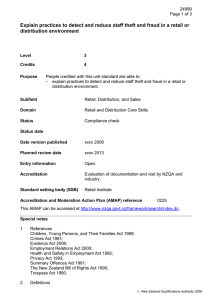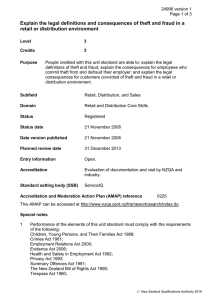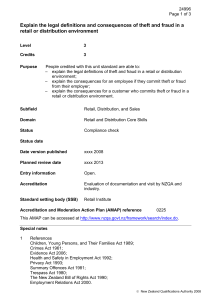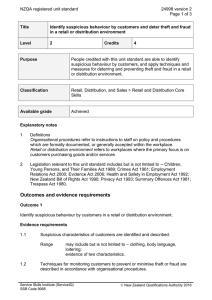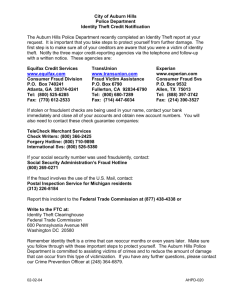Explain practices to detect and reduce staff theft and fraud... distribution environment
advertisement
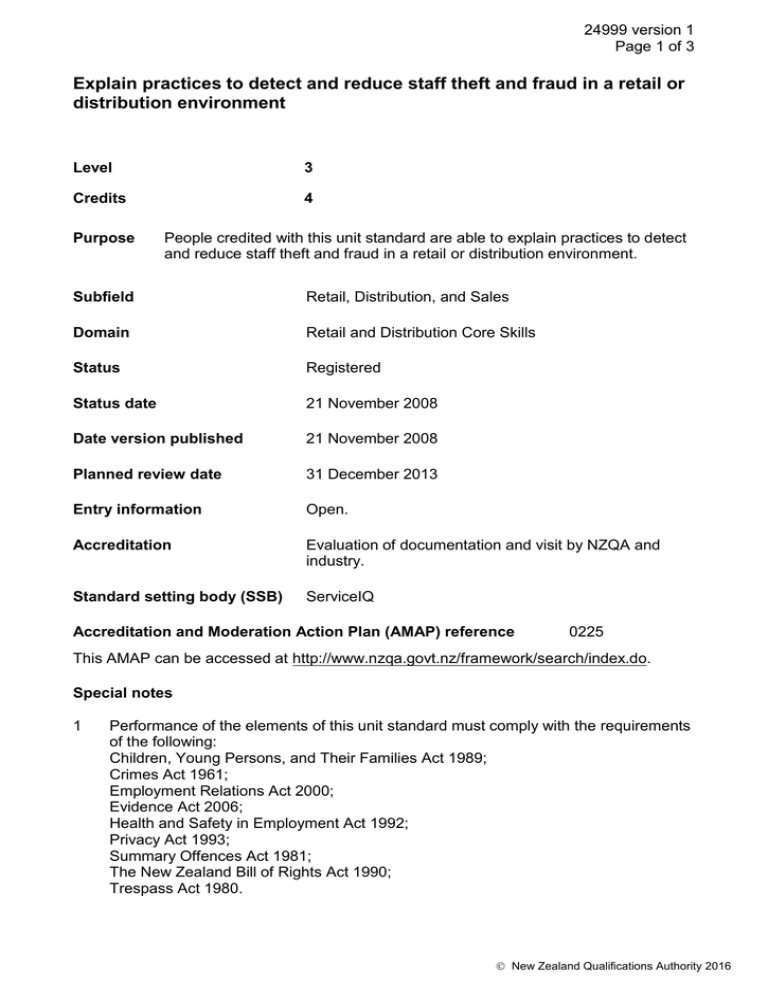
24999 version 1 Page 1 of 3 Explain practices to detect and reduce staff theft and fraud in a retail or distribution environment Level 3 Credits 4 Purpose People credited with this unit standard are able to explain practices to detect and reduce staff theft and fraud in a retail or distribution environment. Subfield Retail, Distribution, and Sales Domain Retail and Distribution Core Skills Status Registered Status date 21 November 2008 Date version published 21 November 2008 Planned review date 31 December 2013 Entry information Open. Accreditation Evaluation of documentation and visit by NZQA and industry. Standard setting body (SSB) ServiceIQ Accreditation and Moderation Action Plan (AMAP) reference 0225 This AMAP can be accessed at http://www.nzqa.govt.nz/framework/search/index.do. Special notes 1 Performance of the elements of this unit standard must comply with the requirements of the following: Children, Young Persons, and Their Families Act 1989; Crimes Act 1961; Employment Relations Act 2000; Evidence Act 2006; Health and Safety in Employment Act 1992; Privacy Act 1993; Summary Offences Act 1981; The New Zealand Bill of Rights Act 1990; Trespass Act 1980. New Zealand Qualifications Authority 2016 24999 version 1 Page 2 of 3 2 Definitions Organisational procedures refer to instructions to staff on policy and procedures which are formally documented, or generally accepted within the workplace. Retail or distribution environment refers to workplaces where the primary focus is on customers purchasing goods and/or services. Elements and performance criteria Element 1 Explain practices to detect and reduce staff theft and fraud in a retail or distribution environment. Performance criteria 1.1 Organisational procedures relating to staff theft and fraud in retail or distribution environment are explained. Range 1.2 may include but is not limited to – cash handling, returns, managing stock, credit card verification, staff purchases, sales to family and friends, discounts, markdowns, cheques, disposal of damaged and out of date stock, bag checks, access and security, confidential information, staff monitoring, collecting evidence, disciplinary action; evidence of three procedures is required with at least one being an example relating to theft and at least one an example relating to fraud. Staff monitoring and/or control systems that assist in detecting and reducing staff theft and fraud are explained in accordance with organisational procedures. Range may include but is not limited to – bag checks, locker checks, staffing rules, purchasing procedures, clocking in and out, access to store and secure areas; counting stock; video surveillance; mystery shoppers; accountability; evidence of three procedures is required with at least one being an example relating to theft and at least one an example relating to fraud. 1.3 Processes for reporting theft and fraud are explained in accordance with organisational procedures. 1.4 Record keeping practices that assist in detecting staff theft and fraud are explained in accordance with organisational procedures. Range may include but is not limited to – cash flow records; sales records; register records; reconciliation discrepancies; voids and refunds; stock take; inventory balances, receiving and forwarding goods; customer exchanges; invoice checking; recording wastage and damaged goods; evidence of three practices is required with at least one being an example relating to theft and at least one an example relating to fraud. New Zealand Qualifications Authority 2016 24999 version 1 Page 3 of 3 1.5 Proactive strategies to reduce staff theft and fraud are explained in accordance with organisational procedures. Range 1.6 may include but is not limited to – staff participation, staff discounts and rewards, training, HR policies, recruitment; evidence of one proactive strategy for theft and one proactive strategy for fraud is required. The impact of staff theft and fraud on a retail or distribution business is explained in terms of the viability of the business. Please note Providers must be accredited by the Qualifications Authority, or an inter-institutional body with delegated authority for quality assurance, before they can report credits from assessment against unit standards or deliver courses of study leading to that assessment. Industry Training Organisations must be accredited by the Qualifications Authority before they can register credits from assessment against unit standards. Accredited providers and Industry Training Organisations assessing against unit standards must engage with the moderation system that applies to those standards. Accreditation requirements and an outline of the moderation system that applies to this standard are outlined in the Accreditation and Moderation Action Plan (AMAP). The AMAP also includes useful information about special requirements for organisations wishing to develop education and training programmes, such as minimum qualifications for tutors and assessors, and special resource requirements. Comments on this unit standard Please contact the ServiceIQ qualifications@serviceiq.org.nz if you wish to suggest changes to the content of this unit standard. New Zealand Qualifications Authority 2016
